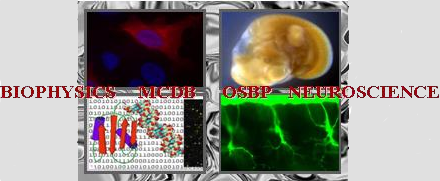Poster abstracts
Poster number 16 submitted by Mithila Agnihotri
Dielectric properties of biomolecules: Methods and Application to DNA oligomer
Mithila Agnihotri , Sherwin Singer
Abstract:
The frequency-dependent dielectric response of DNA in solution probes the dynamics of the
nucleic acid polymer and its counter-ion atmosphere on time scales important for cellular
processes. Recently, the dielectric spectra of short-chain DNA oligomers were measured,
exhibiting an absorption peak corresponding to a 10ns timescale process2. This is the first time
such data is available for oligomers small enough to be accessible to detailed molecular
dynamics simulations. Despite the theoretical and computational challenges described below,
we have been able to confirm that theoretical models can reproduce the 10ns experimental
feature. Our work is now focused on interpretation, and to resolve the conflicting interpretations
which have been proposed in the literature. The dielectric response of DNA is also important
because it can be harnessed to detect trace amounts of DNA as well as manipulate their
motions in micro- and nano-scale biomedical devices1.
The link between DNA dynamics on a molecular level and dielectric response has eluded
scientists for a long time. These properties are not revealed by experimental data alone.
Probing these properties using simulations has proved difficult as well due to large system size,
and long time-scales associated with their motions. Hence one needs to accumulate very long
trajectories, and for which the storage requirements are actually more severe than the
computational requirements needed to generate the trajectory. We have re-formulated the
theory of electrokinetic and dielectric processes in a way that enables calculation of dielectric
properties from both equilibrium and non-equilibrium simulations using sparse sampling of data
without compromising accuracy. We have shown proof-of-principle by calculating the electric
field-induced flow of a simple electrolyte system, and the contribution of ions to its dielectric
spectrum using our very sparse time sampling method. For DNA studies describe above, we
have accumulated an exceptionally long 5 microsecond trajectory for a DNA dodecamer
solvated with 11257 water molecules, and have been able to extract the dielectric spectrum
from sparsely stored data.
References:
1. R. Holzel, Dielectric and dielectrophoretic properties of DNA. IET Nanobiotechnol., 2009, Vol. 3,
Iss. 2, 28– 45
2. Omori S. et al. Dielectric dispersion for short double-strand DNA. Physical Review E, 2006, 73,
050901(R)
Keywords:
